Understanding the Function and Importance of Transmission Pressure Switch in Vehicles
Understanding the Transmission Pressure Switch Function, Importance, and Maintenance
The transmission pressure switch is a critical component in automatic transmission systems, playing a vital role in the safe and efficient operation of vehicles. This small yet significant device monitors the hydraulic pressure within the transmission and communicates with the engine control unit (ECU) to ensure optimal performance. Understanding the function, importance, and maintenance of the transmission pressure switch can help vehicle owners appreciate its role in automotive technology.
Function of the Transmission Pressure Switch
The primary function of the transmission pressure switch is to monitor the hydraulic pressure within the transmission system. When you shift gears, the transmission uses hydraulic fluid pressure to operate its internal components, allowing for smooth gear changes. The transmission pressure switch detects this hydraulic pressure and sends signals to the ECU, enabling it to determine whether the transmission is functioning properly.
There are typically two types of pressure switches normally closed and normally open. In a normally closed switch, the circuit is completed under standard conditions. If the pressure drops below a certain threshold, the switch opens, sending a signal to the ECU that indicates a problem. Conversely, a normally open switch does the opposite—only allowing the circuit to close when the pressure reaches a predetermined level.
Importance of the Transmission Pressure Switch
The transmission pressure switch serves several key purposes, making it an essential component of the transmission system
1. Performance Monitoring The switch helps in monitoring the transmission’s performance by providing real-time data on hydraulic pressure. This information is crucial for optimal shifting and prevents the transmission from entering “limp mode,” where it can only use a limited set of gears to avoid further damage.
2. Preventing Damage By continually assessing the hydraulic pressure, the transmission pressure switch helps prevent potential damage to the transmission. When issues are detected, the ECU can make necessary adjustments or alert the driver to potential problems before they escalate.
3. Fuel Efficiency Proper hydraulic pressure is essential for shifting gears at the right time. A malfunctioning pressure switch can lead to improper shifting, which can negatively impact fuel efficiency and overall vehicle performance.
transmission pressure switch

4. Engine and Transmission Coordination The transmission pressure switch is integral in ensuring that the engine and transmission work together seamlessly. By adjusting the engine's behavior based on transmission pressure readings, it enhances overall drivability and responsiveness.
Maintenance of the Transmission Pressure Switch
Maintaining the transmission pressure switch is crucial for ensuring the longevity and efficiency of the transmission system. Here are some tips for maintaining this critical component
1. Regular Inspections Periodic inspections of the transmission system can help identify potential issues with the pressure switch early. Look for signs of wear, corrosion, or fluid leaks around the switch.
2. Fluid Change Regularly changing the transmission fluid according to the manufacturer’s recommendations can help maintain the health of the transmission and the pressure switch. Contaminated fluid can negatively impact performance and lead to switch failure.
3. Diagnostic Scans Using a diagnostic scanner to read error codes related to the transmission system can help identify issues with the pressure switch. If the check engine light illuminates, it’s essential to have the vehicle diagnosed promptly.
4. Professional Servicing If you suspect issues with the transmission pressure switch, seeking professional help is advisable. A trained technician can perform tests to determine if the switch is functioning correctly or needs replacement.
Conclusion
The transmission pressure switch may seem like a minor component in the complex machinery of an automatic transmission, but its role is indispensable. By monitoring hydraulic pressure, the switch ensures smooth gear transitions, prevents potential damage, enhances fuel efficiency, and maintains the coordinated operation of the engine and transmission. Regular maintenance and timely inspections can help vehicle owners keep their transmission systems running smoothly, ensuring a reliable and efficient driving experience. Understanding the significance of the transmission pressure switch ultimately contributes to better vehicle performance and longevity.
-
Premium Body Chassis Car Solutions Durable Car Body Chassis & Square Body Chassis ManufacturerNewsJun.10,2025
-
Passenger and Commercial Vehicles Versatile Solutions for Every Need High Performance, Reliable SafetyNewsJun.10,2025
-
12 Passenger Vehicles for Rent – Spacious, Comfortable Multi-Passenger Rental OptionsNewsJun.10,2025
-
High-Quality Auto Headlights Durable Designs & Wholesale PricingNewsMay.30,2025
-
70 Seater Coach Hire - Spacious & Reliable Group Transportation SolutionsNewsMay.30,2025
-
High-Efficiency Crop & Land Cultivation Machines for Modern FarmsNewsMay.30,2025
Popular products

























